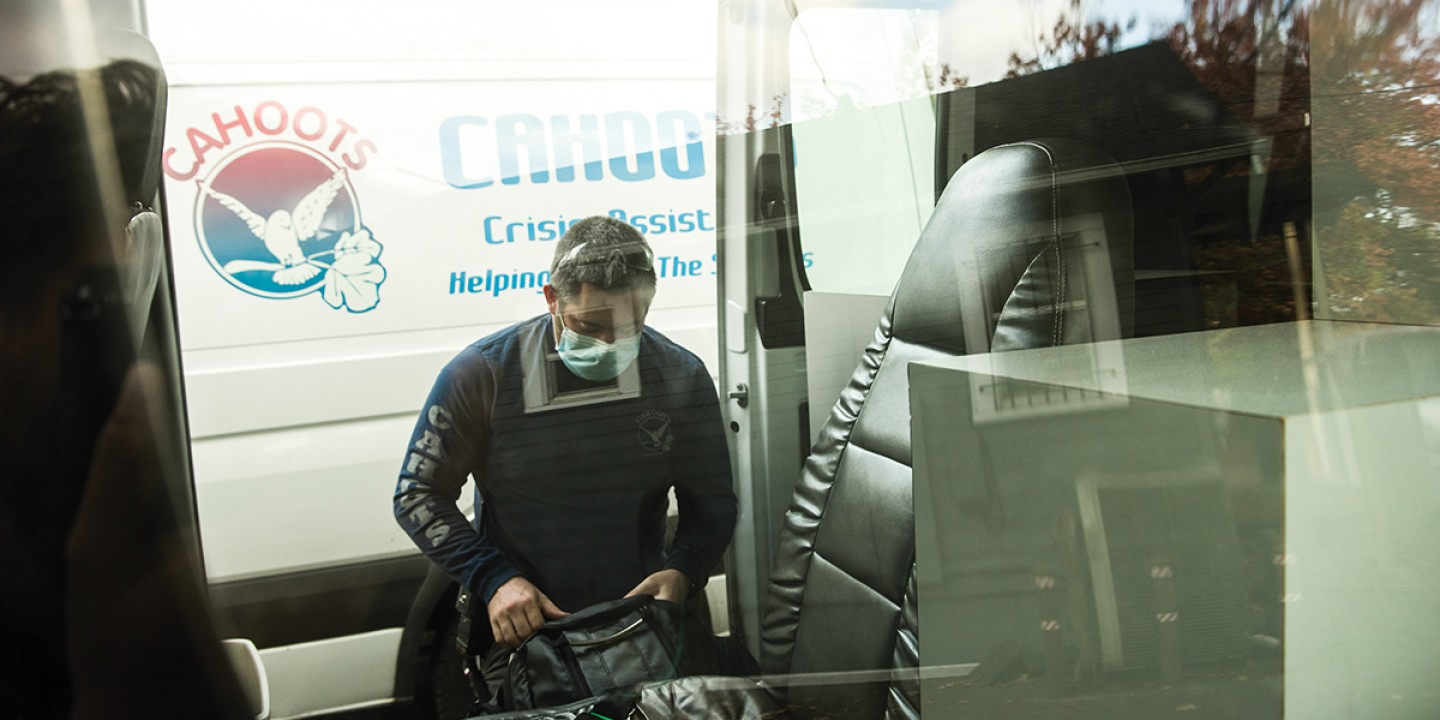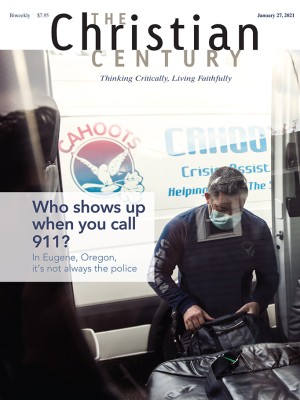In Eugene, civilian response workers are dispatched to nonviolent crises
CAHOOTS is providing a model for rethinking public safety.

When Michelle Perin shows up to work, she has to be prepared for anything.
Some days her 12-hour graveyard shift starts off with a call from 911 dispatch about a person who is feeling suicidal. Perin, an emergency medical technician and crisis worker with the community-based public safety program CAHOOTS—Crisis Assistance Helping Out on the Streets—in Eugene, Oregon, drives a van to the scene, where she and another worker engage the person and assess risk. If the client agrees, they might take them to a hospital, to a crisis center, or into someone else’s care.
Another call might come from someone staying at a shelter. With no access to primary health care, the person needs assistance dressing a wound. Perin drives over, applies the bandage, and reminds the client to call for a bandage change the next day so the wound stays clean. Another call may come in from a family whose foster child, with a history of trauma, needs help calming down. Then she may do a safety check on a person who is intoxicated or has a mental illness and is walking in the middle of the highway, screaming.
Read our latest issue or browse back issues.
Dressed in a hoodie and jeans, Perin is unarmed and has no power to arrest or jail. She doesn’t touch or restrain anyone but instead uses conflict resolution and de-escalation techniques to stabilize situations, and she takes however long is needed to resolve a crisis.
“A lot of it is building rapport,” she said. “It’s letting the person know, ‘We’re here, we’re going to hold space with you while you’re having a really hard time. We’re not going to arrest you and we’re not going to harm you; let’s just do some breathing exercises.’”
After the police killings of George Floyd and Breonna Taylor last year led to nationwide protests for racial justice and calls to abolish or defund the police, cities across the country started looking to CAHOOTS as a better model for public safety. Developed more than 30 years ago, the program uses civilian EMTs and crisis response workers to answer 911 calls regarding nonviolent situations. This reduces the public’s contact with law enforcement, thereby lowering the risk of police violence. Many calls involve mental health emergencies, which nationwide account for up to 50 percent of all fatal encounters with law enforcement, according to the American Journal of Preventive Medicine.
The model has other benefits. It connects residents to appropriate local resources such as housing, mental health support, or a detox center—instead of arresting, jailing, or ticketing them. CAHOOTS estimates it saves the city $8 million in public safety and $14 million in emergency services expenses each year.
CAHOOTS has been hailed as a success in Eugene. But as its model is adopted around the country, it remains to be seen whether these achievements can be replicated.
Over the past 50 years, the United States has undergone a massive increase in policing, according to Nikki Jones, a professor of African American studies at the University of California, Berkeley, whose research focuses on policing and the criminal justice system. Particularly as a result of the war on drugs and 9/11, she said, the mandate of policing expanded so that law enforcement was no longer just responding to crime. Instead, it became proactive in searching for signs of social disorder that could lead to crime—rowdy teenagers gathering on a street corner or a person sleeping in front of a business.
Policing also became more militarized: officers are now armed with assault rifles, flash grenades, tanks, and other surplus military equipment. At the same time, the country’s social safety net contracted, and police became the primary responders to incidents resulting from homelessness, mental health crises, and substance abuse. The more contact law enforcement had with the public, the more arrests, jail time, and violence occurred.
In 2020, 1,000 people were shot and killed by police officers, according to the Washington Post’s police shooting database. Other recent years have seen similar numbers of fatal shootings. Black people are killed at a rate more than twice that of White people.
“Violence is central to policing,” said Jones. “And you can’t get away from that—that policing is essentially the management of the distribution of violence.”
While calls to abolish or defund the police have gained traction in recent months, Jones noted that protests against the expansion of law enforcement are nothing new. A variety of models in use now attempt to separate policing from mental health crisis response. On one end of the spectrum are critical response teams of police officers with special training in mental health, which have been established in police departments across the country over the last few decades, she said. On the other end are programs such as Mental Health First, part of the Oakland Anti Police-Terror Project, which trains community members to respond to mental health crises and dispatches them to situations completely independent of the police or state.
In the middle is CAHOOTS. Run by White Bird Clinic, a long-standing health clinic in Eugene that offers an array of social services, CAHOOTS is formally a part of the city’s emergency response system and is dispatched by police departments in Eugene and Springfield, a neighboring city. Funding for CAHOOTS comes from the city government. While CAHOOTS teams operate separately from the police, they can call for police backup if needed. (In 2019 CAHOOTS called for backup on just 1 percent of calls.) This complex relationship is where the name of the organization comes from, said Perin. “It’s tongue-in-cheek: we’re in cahoots with the police.”
The 24-hour, seven-days-a-week, free program employs about 40 workers—each required to complete more than 500 hours of de-escalation and crisis intervention training—to operate three vans in Eugene and Springfield. Last year CAHOOTS responded to 24,000 calls, or 17 percent of all calls dispatched by 911.
Community leaders say CAHOOTS has been an important resource for residents. “People feel confident to call CAHOOTS to seek help for mental illness or addiction when their relative is a person of color, because they trust CAHOOTS more than they trust the police,” said Ibrahim Coulibaly, president of the NAACP in Eugene and Springfield. He works at a state hospital and said that, in the past, patients with mental illness were typically admitted after they committed a crime or became a danger to themselves or others. But more recently, he said, patients are coming to seek treatment before they cause harm. “The family feels more comfortable calling for help knowing their loved one won’t go to jail but will be taken to treatment than if the police were the only resource they had to call,” he said.
Rico Perez, president of the Eugene-based Community Alliance of Lane County, agreed on the positive impact CAHOOTS has had on the city. “The alternative they are offering is one that probably should have been offered ages ago,” he said.
Even with the close relationship between CAHOOTS and the police, UC Berkeley’s Jones said CAHOOTS aligns with recent calls for abolishing or defunding the police—because it fundamentally reimagines the way society responds to harm. “There is harm done to a person as they’re experiencing a mental health crisis,” she said. “The problem is not that they’re in the street disrupting traffic; the problem is that they’re in crisis. So to think about it in that way, then you’re responding to harm—you’re relating to a person through their humanity, which is not what policing does. That paradigm shift is part of an abolitionist project.”
One of the first cities to replicate CAHOOTS was Olympia, Washington. Three years ago, city residents voted to fund a variety of public safety measures, including a program that became the mobile Crisis Response Unit under the Olympia Police Department, said Anne Larsen, outreach services coordinator for the department. The chief of police at the time had been an officer in Eugene, she said, and wanted to implement a program similar to CAHOOTS. Larsen traveled to Eugene to see firsthand how CAHOOTS operates and then worked closely with the program for the next two years until CRU was launched in April 2019.
CRU operates under the same basic paradigm: teams of two unarmed behavioral health specialists are dispatched to handle nonviolent crises. The specialists—who communicate over police radio and can be dispatched directly by police—de-escalate situations and transport clients to seek additional resources. They can also call for police assistance. “We’re focusing on using the right tool for the situation,” Larsen said.
She said one key addition to the CAHOOTS model is long-term care, since many clients are in chronic crisis. If CRU personnel or police connect with someone three or more times over a six-month period, that person qualifies to enter a program called Familiar Faces. They receive wraparound services and case management from peer navigators who have lived experience with incarceration, mental illness, and addiction. “The peers can spend a year or two years—whatever amount of time it takes—to stabilize folks in our community, and that’s where this collaborative partnership between short-term response and long-term response will hopefully improve the lives of everyone,” she said.
Between April 1 and June 30, CRU handled more than 500 cases, on average more than five per day. Larsen said CRU was critical at the onset of the pandemic, when public transportation shut down and many service providers went online. During this time, CRU provided 200 transports, most of them to hospitals and methadone clinics.
This summer another CAHOOTS-inspired program launched in Denver. Called Support Team Assisted Response, it grew out of years of pushing for local criminal justice reform, said Vinnie Cervantes, organizing director for the Denver Alliance for Street Health Response, the community facilitator for the STAR program. He had long been focusing on issues such as use of force policy and accountability in the district attorney’s office, but these reforms were taking too long to implement. He saw in CAHOOTS a model that could make an immediate difference in keeping people out of jail. In 2017 he presented the idea to the city, and in June, the six-month pilot was launched.
Cervantes said STAR’s pilot is designed to gather data on what kinds of services are needed, where clients are, and when they need help, all to inform the full rollout next year. STAR operates similarly to CAHOOTS but on a limited basis. The mobile vans are running in only two neighborhoods in the city, and the hours are 10 a.m. to 6 p.m., weekdays only. It’s also housed under the Denver Police Department. In its first three months, STAR has responded to an estimated 600 calls, he said, or about ten calls per day. Cervantes said that eventually he wants to see STAR available for the entire city, 24 hours a day, seven days a week. He also wants the program to be run by the community rather than the police department.
And since Denver is so much bigger than Eugene—almost four times the size and population—it may require several community partners to operate. “We want to make it something that lives in the community like CAHOOTS does, because I think if it doesn’t live in the community, it’s going to be an extension of the police department and an extension of that same systemic harm,” Cervantes said. The community, he said, also needs to do its part by increasing resources—like additional shelters and substance abuse treatment—to ensure STAR succeeds.
Cervantes said STAR is working to replicate its model in other cities in Colorado, including Aurora, where Elijah McClain, a Black, unarmed 23-year-old, was killed in 2019 after police placed him in a choke hold. “We hope that it’s something that cities of all sizes, demographics, and budgets can implement,” he said.
CAHOOTS is working with additional cities to get new programs off the ground in the aftermath of the Black Lives Matter protests this summer. In Oakland, which has a long history of police violence—the Black Panther Party for Self Defense was founded there in part as a response to local police brutality—the city council recently approved a pilot program called Mobile Assistance Community Responders of Oakland. While the protests pushed the city to adopt the pilot, MACRO had long been in the works, said Anne Janks, an organizer at the Coalition for Police Accountability and project leader for MACRO.
After Oakland police shot and killed an unhoused man sleeping with a gun in his hand in 2018, residents and community leaders came together to demand greater accountability and develop alternatives to policing, Janks said. During this process, she learned about CAHOOTS and brought a team to California to start planning what such a program could look like in Oakland. “CAHOOTS gave us a belief that this particular model could work,” she said.
Janks envisions MACRO creating good jobs in the same marginalized communities it serves. This means the EMTs and crisis workers will be paid well enough to afford the high cost of living in the San Francisco Bay Area, she said. “Homeless outreach workers, harm reduction folks, they’re paid somewhere between $15-$25 an hour,” she said. “You literally cannot afford to live in Oakland with that. If you’re saving money by displacing police officers, who are so highly paid, we’re not going to save the money on the backs of the people who are saving them money.” It also means lowering the barriers to entry to include those with lived experience—including the formerly incarcerated—and recruiting candidates who represent the cultural and linguistic diversity of the city.
As the CAHOOTS model spreads throughout the country—programs are beginning in San Francisco, New York City, Indianapolis, Hartford, Albuquerque, and several cities in Oregon—it could get a boost from Congress. In August, Democratic senators Ron Wyden of Oregon and Catherine Cortez Masto of Nevada proposed the CAHOOTS Act, which would increase Medicare funding to states to establish and run mobile crisis units. “It’s long past time to reimagine policing in ways that reduce violence and structural racism, and health care can play a key role in that effort,” Wyden said in a statement. “Oregon has a proven model in the CAHOOTS program, and I want other states and communities to have federal resources to pursue similar approaches. . . . CAHOOTS is proof positive there is another way.”
Perin, the CAHOOTS worker, said that while CAHOOTS can provide a template, it’s not one size fits all. “Communities need to recognize that they may want a CAHOOTS model, but it may look nothing like ours,” she said. “It needs to be community built. Each community needs to say, ‘What does our community need to put this into place? What does our community want?’ I hear a lot of people say, ‘Oh, that works really well in the liberal West in this small hippie town,’ and OK, fine, we’ve built our niche. What is this going to look like for you when you build this from the ground up?”
CAHOOTS has its limitations. Perin said one challenge is giving clients a way to seek help without dialing 911, since many marginalized residents don’t want to risk the exposure to police contact. The program is now working to set up another phone number that clients can use. Perin said there’s also been some distrust from police, especially this summer after CAHOOTS was held up as a model alternative to policing after the Black Lives Matter protests swept the country. “There’s been a lot of questions both [from] leadership but also individual officers, personally and professionally, who are like, ‘Are you with us or against us?’” she said.
Even though their cost savings has been proven, CAHOOTS and similar programs will still likely face a challenge in funding, said Jones of UC Berkeley. In Oakland, the police department was allocated $300 million this year—more than 40 percent of the city’s general fund. MACRO requested just 1 percent of that, $3 million, for its pilot. The CAHOOTS budget for this year is about $2 million, compared to $90 million for both the Eugene and Springfield Police Departments.
This means that when programs are evaluated for their success relative to policing, they’re always going to come up short. “If these programs had the same funding that law enforcement has, there’d be no question . . . they would be successful,” said Jones. “That’s where I see a sticking point. You have pilot projects unfolding, but do they have the kinds of support they need, and in the end when they’re compared to a police response, are you comparing responses that are as well supported as the police are?”
It may also take years—not months or one year of a pilot—to measure the true impact of these alternative programs, and lawmakers may not have the patience to wait that long, Jones said. “I fear retrenchment all the time,” she said. “If one encounter . . . goes badly, people might have a knee-jerk response and pull away from this kind of investment. But I think it’s something we have to be committed to for the long haul.”
But with all the attention CAHOOTS is now receiving, Perin, who’s been working at CAHOOTS for the last four years, said she hopes the program at least challenges the way people think about what keeps them safe.
“I think we need to broaden that definition of what makes the public safe,” she said. “When you say ‘public safety’ most of the time, people just think of the police. But no, that’s not necessarily the only thing that makes people safe.”
A version of this article appears in the print edition under the title “Who shows up when you call 911?”






